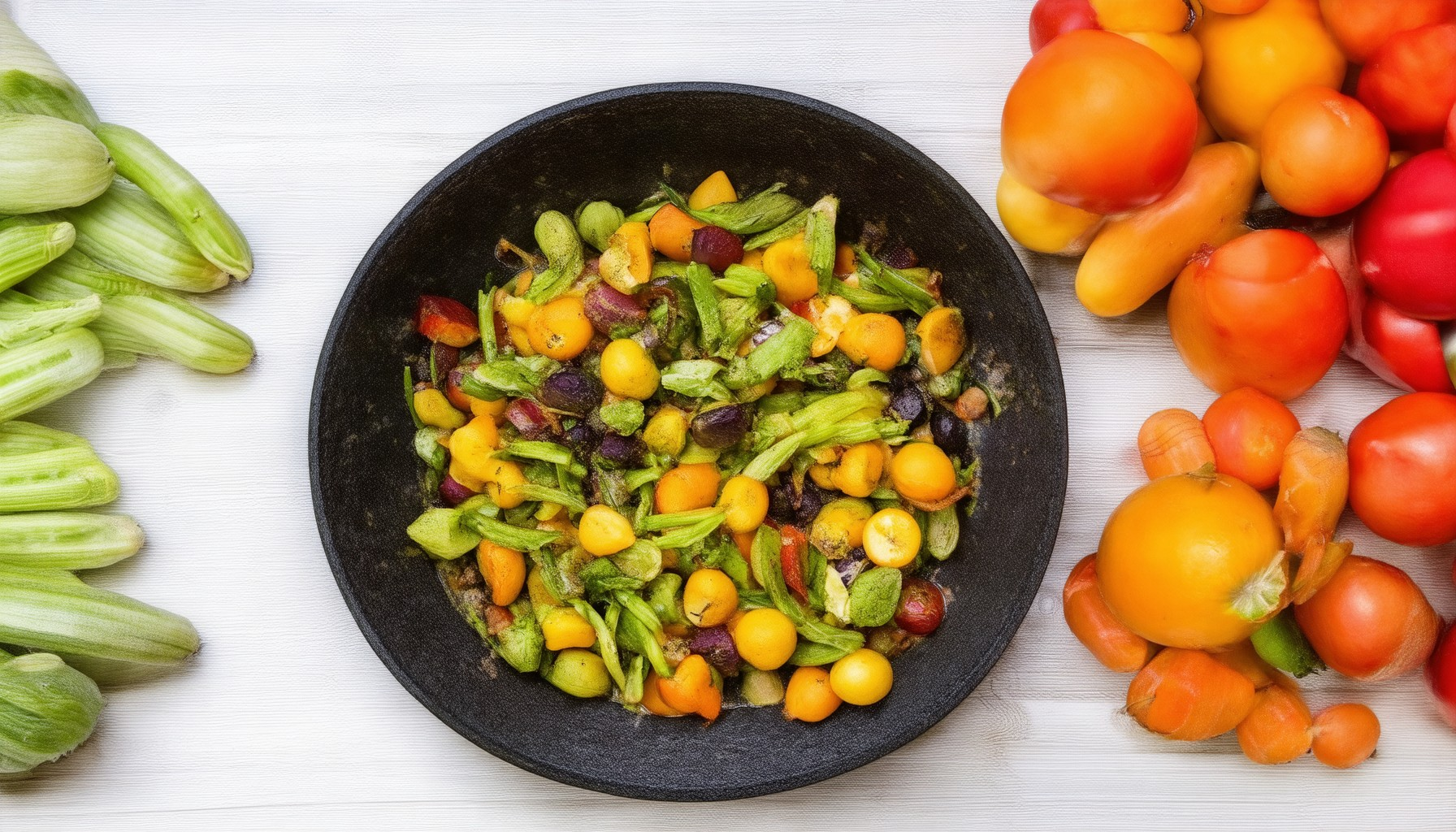Discover the art of enhancing your culinary skills with the freshest, most vibrant ingredients nature has to offer. In today’s fast-paced world, cooking has evolved beyond mere survival instincts, transforming into a craft that celebrates the seasons. At its core, cooking with seasonal produce isn’t just about following recipes—it’s about embracing the essence of each season, respecting the land, and savoring the flavors that only mother nature can provide. From the crisp, earthy tones of winter squash in cooler months to the juicy sweetness of summer berries, seasonal cooking offers a unique dining experience that’s as nourishing as it is delightful.
Key Takeaways
- Adopting seasonal recipes enhances flavor and nutrition by utilizing fresh, in-season ingredients.
- Seasonal produce reduces pesticide exposure and supports eco-friendly farming practices.
- Fresh, in-season foods offer higher vitamin and mineral content, promoting better health.
- Eating with the seasons provides diverse ingredients, keeping meals exciting and varied.
- Local, seasonal consumption lowers carbon footprints and supports sustainable agriculture.
- Seasonal ingredients are often more affordable and readily available, making meal planning easier.
- Chef advocacy highlights the importance of using seasonal ingredients for healthier, flavorful dishes.
- Incorporating seasonal eating into meals can transform diets and environmental impact positively.
- Popular seasonal fruits and veggies vary by season, offering unique flavors and nutrients each time of year.

How Do You Eat Produce Seasonally?
Eating seasonally is a fantastic way to enjoy fresh, flavorful produce while supporting local farmers and reducing your environmental impact. Here’s how you can incorporate seasonal eating into your lifestyle:
Benefits of Eating Seasonally
- Healthier Choices: Seasonal produce is naturally richer in vitamins and minerals, as it ripens closer to harvest.
- Sustainability: Eating locally reduces transportation emissions and supports eco-friendly farming practices.
- Unique Flavors: Each season offers distinct flavors that can inspire creative cooking.
- Reduces Waste: Fresh produce that doesn’t get eaten often ends up in landfills. Eating seasonally helps minimize waste.
How to Get Started
Start by exploring your local area for farmers’ markets, farm stands, or Community Supported Agriculture (CSA) programs. These are great ways to connect with local producers and discover what’s in season. You can also check out our Seasonal Recipes collection for inspiration.
Planning Meals with Seasonal Produce
Plan your meals around what’s available during each season. Visit our Seasonal Produce Guide for tips on what to look for and how to prepare it. Don’t be afraid to mix and match flavors—you might find new favorites!
Storing Seasonal Produce
Once you bring seasonal produce home, make sure to store it properly to maximize shelf life. For example:
- Bananas and Apples: Let them ripen on the counter before storing in the fridge.
- Kale and Spinach: Store in cold water or wrap in paper towels to keep them crisp.
- Herbs: Snip off stems and store in glass containers with lids to retain moisture.
Experiment and Enjoy!
Don’t be afraid to try new things! Seasonal produce is versatile and can be used in a variety of dishes. Plus, it’s a great excuse to cook more often and explore new recipes. Remember, cooking with fresh, seasonal ingredients makes every meal more delicious and nutritious.
By eating seasonally, you’re not just nourishing your body—you’re also contributing to a healthier planet. Happy eating!
How Do You Cook Seasonally?
Cooking seasonally involves incorporating ingredients that are naturally available during their respective growing seasons. This approach ensures fresh, flavorful dishes while supporting sustainable food systems. Here’s a guide to help you embrace seasonal cooking:
- Choose Ingredients Based on Availability: Opt for fruits, vegetables, and meats that are in season. These ingredients are typically fresher and more flavorful.
- Preserve Seasonal Foods: Learn techniques like pickling, freezing, or fermenting to enjoy seasonal produce year-round.
- Explore Farmers’ Markets: Visit local markets to discover what’s in season and connect with producers who prioritize quality and sustainability.
- Plan Menus Around Seasonality: Create meal plans that highlight the best of the current season, from spring greens to winter roots.
The Benefits of Seasonal Cooking
Cooking with seasonal ingredients offers numerous advantages:
- Freshness and Flavor: Seasonal produce is often tastier and more nutritious.
- Nutritional Value: Many seasonal foods contain higher vitamin and mineral content due to natural ripening.
- Sustainable Practices: Eating seasonally reduces reliance on imported foods and supports local economies.
- Environmental Impact: Minimizing transportation costs associated with out-of-season produce helps reduce carbon footprints.
Examples of Seasonal Dishes
Experiment with these seasonal favorites:
- Spring: Fresh salads, herb-infused risottos, and light soups featuring asparagus, strawberries, and young spinach.
- Summer: Grilled meats, vibrant fruit desserts, and cold soups like gazpacho, highlighting tomatoes, melons, and peaches.
- Autumn: Roasted squash, hearty stews, and pies made with apples, pumpkins, and sweet potatoes.
- Winter: Warm soups, braised meats, and festive dishes like roasted root vegetables and citrus-infused desserts.
By embracing seasonal cooking, you’ll not only enjoy healthier, tastier meals but also contribute to a more sustainable food future. Explore our seasonal recipe collection for inspiration and learn how to make the most of what’s in season!

Why is seasonal produce healthier than produce purchased out of season?
Seasonal produce is generally considered healthier due to several factors:
- Higher Nutrient Density : Produce grown in its natural season tends to have higher levels of essential vitamins, minerals, and antioxidants. This is because the plants are naturally ripened under optimal conditions, maximizing nutrient content.
- Increased Antioxidant Levels : Fruits and vegetables in season often contain higher concentrations of antioxidants like vitamin C, carotenoids, and flavonoids, which help combat oxidative stress and promote overall health.
- Better Flavor and Texture : In-season produce typically has superior taste and texture, making it more enjoyable to eat and thus more likely to be consumed in larger quantities.
- Reduced Exposure to Pesticides : Many out-of-season crops require more synthetic pesticides and chemicals to survive the stressful conditions of being harvested before maturity. Seasonal produce, grown in their natural environment, often requires fewer pesticides, reducing exposure risks.
- Freshness and Quality : Freshly harvested seasonal produce retains more of its natural moisture and nutrients, ensuring higher quality and a longer shelf life compared to out-of-season produce that may have been harvested prematurely.
- Support for Local Agriculture : Purchasing seasonal produce supports local farmers, helping to sustain rural economies and promoting sustainable agricultural practices.
By choosing seasonal produce, you benefit from higher nutrient content, better taste, and reduced exposure to harmful chemicals, making it a healthier and more enjoyable choice for your diet.

Why We Adapt Recipes to Include Seasonal Foods
Adapting recipes to incorporate seasonal foods offers numerous benefits, from enhancing flavor and nutrition to supporting environmental sustainability. Here’s a breakdown of the key reasons:
- Availability and Flavor: Seasonal foods are naturally abundant during specific times of the year, ensuring fresh and flavorful ingredients. This abundance allows chefs and home cooks to create vibrant, seasonal dishes that wouldn’t be possible with out-of-season produce.
- Reduction in Pesticide Use: Produce harvested in its natural season typically requires fewer pesticides compared to fruits and vegetables grown out of season. This reduces exposure to harmful chemicals and supports eco-friendly farming practices.
- Nutritional Value: Fresh, in-season foods often retain higher levels of vitamins, minerals, and antioxidants. These nutrients can diminish when produce is harvested prematurely or transported over long distances.
- Diverse Meal Options: Eating with the seasons provides a wider variety of ingredients, allowing for creative recipe development. This diversity keeps meals exciting and caters to different tastes and dietary needs throughout the year.
- Environmental Impact: Consuming locally grown, seasonal produce reduces the carbon footprint associated with long-distance transportation. It also supports sustainable farming practices that protect the environment and promote biodiversity.
- Economic Support: Purchasing seasonal goods directly from local farmers helps stimulate rural economies and ensures fair trade practices. It also guarantees that farmers receive consistent demand for their products.
- Health Considerations: Seasonal foods are often less likely to be treated with synthetic additives, further reducing potential health risks associated with prolonged storage or transport.
By embracing seasonal ingredients, we not only enjoy fresher, tastier meals but also contribute to a healthier planet and stronger local communities.
How Would Seasonal Products Influence Your Recipes?
Seasonal products play a significant role in enhancing your recipes by offering fresh, flavorful ingredients that elevate dishes to new heights. Here’s how seasonal products can influence your cooking:
- Freshness and Flavor Enhancement: Seasonal ingredients are harvested at peak ripeness, ensuring optimal flavor and aroma. This freshness translates directly into your recipes, providing a more vibrant taste experience.
- Sustainability and Local Support: By using seasonal products, you support local farmers and contribute to a more sustainable food system. This reduces carbon footprint and promotes eco-friendly practices.
- Nutritional Value: Seasonal fruits, vegetables, and herbs often contain higher levels of vitamins, minerals, and antioxidants due to their natural growing conditions. This means your recipes can offer greater nutritional benefits.
- Variety and Creativity: Seasonal products introduce new ingredients that inspire creativity in the kitchen. This variety prevents meal monotony and allows you to experiment with unique flavor combinations.
- Eco-Friendly Impact: Consuming seasonal products helps reduce waste, as there’s less reliance on long-distance transportation and storage. This aligns with global efforts toward reducing food waste.
- Cost-Effectiveness: Seasonal produce is often more affordable and readily available, making it a budget-friendly option for home cooks.
- Health Benefits: The natural ripening process of seasonal products preserves enzymes and nutrients, contributing to better digestion and overall health.
To make the most of seasonal products in your recipes, consider these tips:
- Plan Meals Around What’s in Season: Visit local farmer’s markets or check seasonal produce guides to see what’s available.
- Experiment with New Ingredients: Try incorporating seasonal fruits, vegetables, and herbs into traditional recipes for a refreshing twist.
- Preserve the Harvest: Learn simple preservation techniques to enjoy seasonal flavors year-round.
By embracing seasonal products, you not only enhance your recipes but also contribute to a healthier planet and community. Start exploring the vibrant flavors of the season and take your cooking to the next level!
[Link to seasonal recipe ideas](https://memories-restaurant.com/seasonal-recipes)

Seasonal Eating Trend
Seasonal eating is a dietary approach that emphasizes consuming fruits, vegetables, and other foods that are in season according to their natural growing cycles. This trend highlights the idea of eating locally grown and fresh produce, which offers numerous health benefits and supports sustainable agriculture.
Benefits of Seasonal Eating
- Nutrient Density: Produce harvested at peak ripeness tends to have higher vitamin and mineral content, providing greater nutritional value.
- Reduced Pesticide Exposure: Foods eaten in season are typically harvested earlier, reducing prolonged storage and exposure to pesticides.
- Environmental Impact: Consuming locally grown foods reduces transportation emissions and supports eco-friendly farming practices.
- Flavor and Quality: In-season fruits and vegetables often have better taste and texture due to natural ripening processes.
Popular Fruits and Vegetables by Season
- Spring: Strawberries, Asparagus, Spinach
- Summer: Watermelon, Tomatoes, Cucumbers
- Autumn: Apples, Pumpkins, Squash
- Winter: Citrus Fruits, Kale, Brussels Sprouts
Chefs and Experts Advocating for Seasonal Eating
Many chefs and nutritionists, including those at Memories Restaurant , emphasize the importance of seasonal eating. Our culinary team believes that cooking with ingredients that are in season ensures dishes are not only healthier but also more flavorful.
How to Incorporate Seasonal Eating
Start by visiting your local farmers’ market or checking out our recipe section for inspiration on how to prepare seasonal ingredients. Experiment with different recipes and enjoy the natural flavors that each season has to offer!
Conclusion
Adopting a seasonal eating lifestyle can transform your diet and your health. By choosing to eat what’s in season, you’re not only doing something kind to the environment but also treating yourself to the freshest, most nutritious foods possible. Remember, nature provides the best ingredients, and Memories Restaurant is here to help you make the most of them!





0 Comments